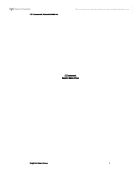Part 1: 2D Shapes:
1st term: 2nd term:
3rd term: 4th term:
5th term: 6th term:
7th term: 8th term:
9th term:
Part 1: 2D Shapes:
Table to show the amount of squares in total and the amount of extra squares used for the 2D drawing:
Working out to show the equation (nth term) for the Extra Squares used.
0 4 8 12 16 20 24 28 32
+4 +4 +4 +4 +4 +4 +4 +4
Therefore the first part of the equation is 4n.
To find out the next part of the equation, I will need to see how the number 4 is related to the value of ‘n’ and work out the difference, to find out the remaining equation.
When n= 1 the number of extra squares is 0.
So: 1*4=4
4+/- x= 0
x= -4
General equation for Linear sequences: an+ b
So the equation is: 4n-4.
To make sure the equation is correct; I will check it using values of ‘n’.
When n = 2, the number of extra squares is 4.
So: 2 * 4 = 8
8 – 4 = 4
The answer matches the answer in the sequence so the equation is correct, but I will check again to be sure.
When n = 5, the number of extra squares is 16.
So: 5 * 4 = 20
20 – 4 = 16
The equation is correct as both times the answers have matched those in the sequence.
Working out to show the equation (nth term) for the Total Squares used.
1 5 13 25 41 61 85 113 145
+4 +8 +12 +16 +20 +24 +28 +32
+4 +4 +4 +4 +4 +4 +4
- 2a = 4 2) 3a + b = 4 3) a + b + c = 5
a = 2 6 + b = 4 2 + 2 + c = 5
b = -2 c = 1
General equation for Quadratic sequences: an2 + bn + c
So the equation for this sequence is: 2n2 - 2n + 1
To check that the equation is correct I will use values of ‘n’ to make sure.
When n= 4, the total number of squares used are 25.
So: 2 * (42) – (2*4) + 1 = 25
This shows the equation is correct. I will however, check again to be sure of this.
When n = 9, the total squares used are 145.
So: 2* (92) – (2*9) + 1 = 145
This tells that the equation works and is therefore correct.
Part 2: 3D Shapes:
(The 3D drawings are on the triangle dotted paper attached.)
Table to show the amount of squares in total and the amount of extra cubes used for the 3D drawings:
Working out to show the equation (nth term) for the Total Cubes used.
Sequence:
1 7 25 63 129
+6 +18 +38 +66
+12 +20 +28
+8 +8
Cubic sequence :
1 8 27 64 125
+7 +19 +37 +61
+12 +18 +24
+6 +6
General equation for Cubic sequences: an3 + bn2 + cn + d
To find ‘a’ in the formula:
a= 3rd difference in sequence
3rd difference in cubic sequence
So: 8/6 = 4/3 =1⅓
Therefore the first part of the equation is: 1⅓ n3 + bn2 + cn + d
New sequence:
-1/3 -11/3 -33/3 -67/3 -113/3
-10/3 -22/3 -34/3 -46/3
-12/3 -12/3 -12/3
General Quadratic equation: bn2 + cn + d
2b= -12/3 (-4)
b= -6/3 (-2)
3b + c= -10/3
-18/3 (-6) + c= -10/3
c= 8/3 (2 2/3)
b + c +d= -1/3
-6/3 + 8/3 + d = -1/3
d= -1
Remaining equation for total number of cubes used in any 3D cross- shape: -2n2 + 22/3n – 1
Full equation to work out the total cubes needed to make any 3D cross- shape:
11/3n3 -2n2 + 22/3n – 1
To check the formula works, I will test it using values of ‘n’.
When n= 1, the total cubes used is 1.
So: (1⅓ * 13) – (2 * 12) + (22/3 * 1) – 1
= 1⅓ - 2 + 22/3 -1 = 1
This shows that the formula works, but I will check again, in case I have made a mistake.
When n= 5, the total cubes used are 129.
So: (1⅓ * 53) – (2 * 52) + (22/3 * 5) – 1
= 125⅓ -50 +72/3 -1 = 129
This proves that my formula is correct because the answers match those in my sequence.
1st term 2nd term 3rd term
4th term 5th term
Justification of 2D shapes:







